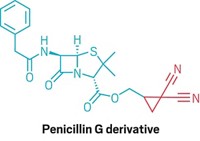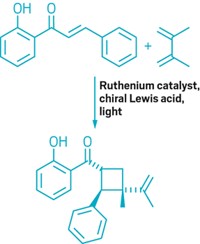Advertisement
Grab your lab coat. Let's get started
Welcome!
Welcome!
Create an account below to get 6 C&EN articles per month, receive newsletters and more - all free.
It seems this is your first time logging in online. Please enter the following information to continue.
As an ACS member you automatically get access to this site. All we need is few more details to create your reading experience.
Not you? Sign in with a different account.
Not you? Sign in with a different account.
ERROR 1
ERROR 1
ERROR 2
ERROR 2
ERROR 2
ERROR 2
ERROR 2
Password and Confirm password must match.
If you have an ACS member number, please enter it here so we can link this account to your membership. (optional)
ERROR 2
ACS values your privacy. By submitting your information, you are gaining access to C&EN and subscribing to our weekly newsletter. We use the information you provide to make your reading experience better, and we will never sell your data to third party members.
Synthesis
Photocatalysis With Visible Light
September 15, 2008
| A version of this story appeared in
Volume 86, Issue 37
To marshal their reagents into action, chemists often turn to the energizing power of light. Most organic compounds, however, only react when they absorb high-frequency ultraviolet light, and the specialized photoreactors needed for such syntheses allow only a few photocatalytic reactions to make it beyond the lab to large-scale operations. Recently, chemists have turned to the popular ruthenium bipyridine complex, Ru(bpy)32+, to harness energy from lower energy visible wavelengths and inject electrons into reactions with organic molecules (C&EN, Sept. 8, page 10). Tehshik P. Yoon of the University of Wisconsin, Madison, and coworkers have now applied this strategy to [2+2] cycloadditions of enones (J. Am. Chem. Soc., DOI: 10.1021/ja805387f). The researchers found they could get aryl bis(enones) to undergo intramolecular cyclization (shown) with Ru(bpy)32+, a few key additives, and a standard floodlight. The reaction proceeds in good yield, with excellent diastereoselectivity. An intermolecular dimerization of untethered aryl enones also worked well. "This approach to effecting visible light photocatalysis has enormous potential for the development of new reaction protocols with reduced environmental impact," the researchers note.






Join the conversation
Contact the reporter
Submit a Letter to the Editor for publication
Engage with us on Twitter